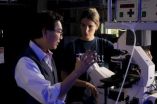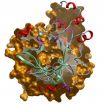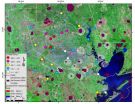(Press-News.org) HIV-infected individuals who begin antiretroviral therapy (ART) soon after acquiring the virus may have stronger immune responses to other pathogens than HIV-infected individuals who begin ART later, a new study from the National Institutes of Health has found. This finding suggests that early initiation of ART may prevent irreversible immune system damage and adds to the body of evidence showing significant health benefits from early ART.
Scientists from the National Institute of Allergy and Infectious Diseases, part of NIH, measured the quantity and qualities of B cells in blood samples taken from three groups of study volunteers: men who had been infected with HIV for fewer than 6 months; men who had been infected with HIV for 6 months or more (often for several years); and men who were not infected with HIV. The HIV-infected men began taking ART for the first time once they entered the study.
B cells make proteins called antibodies that can flag pathogens for destruction by the immune system and prevent them from infecting cells. At the outset of the study, the number of B cells in the blood of both groups of HIV-infected men was significantly lower than the number of B cells in the blood of the uninfected men. Once the two groups of HIV-infected men began ART, however, the numbers of B cells in their blood increased significantly and to similar degrees.
Qualitatively, however, the compositions of B cells in the two groups of HIV-infected men differed notably throughout the study. The researchers compared the relative proportions of six different types of B cells within and among each of the three groups at the study outset and one year after the HIV-infected men had started ART. The scientists observed that early treatment restored resting memory B cells to the same level as that in HIV-uninfected men, but late treatment did not. Resting memory B cells remember how to make antibodies to a pathogen and can last a lifetime. Also, early ART reduced the proportion of immature B cells to the same level as that in HIV-uninfected men, but late treatment did not. In addition, after one year, the late-treatment group had a significantly greater proportion of so-called exhausted B cells—those that have shut themselves off and resist doing their usual pathogen-fighting activities—compared with the other two groups of participants.
To learn how these differences affected immune system responses to new infections, the research team examined how the two groups of HIV-infected men responded to influenza vaccination at the start of the study and one year after beginning treatment. At the one-year point, a significantly greater proportion of B cells made anti-influenza antibodies in the early treatment group compared with the late treatment group. This suggests that starting ART early in the course of HIV infection enables individuals to fight off other pathogens better than if they start ART later, when the infection has become chronic.
INFORMATION:
ARTICLE: S Moir et al. B cells in early and chronic HIV infection: evidence for preservation of immune function associated with early initiation of antiretroviral therapy. Blood Sept. 13, 2010 (e-pub ahead of print).
Anthony S. Fauci, M.D., NIAID director and chief of the Laboratory of Immunoregulation, and Susan Moir, Ph.D., associate scientist in the NIAID Laboratory of Immunoregulation, are available to discuss the findings.
To schedule interviews, please contact Laura Sivitz Leifman, 301-402-1663, niaidnews@niaid.nih.gov.
NIAID conducts and supports research—at NIH, throughout the United States, and worldwide—to study the causes of infectious and immune-mediated diseases, and to develop better means of preventing, diagnosing and treating these illnesses. News releases, fact sheets and other NIAID-related materials are available on the NIAID Web site at http://www.niaid.nih.gov.
The National Institutes of Health (NIH)—The Nation's Medical Research Agency—includes 27 Institutes and Centers and is a component of the U. S. Department of Health and Human Services. It is the primary federal agency for conducting and supporting basic, clinical and translational medical research, and it investigates the causes, treatments and cures for both common and rare diseases. For more information about NIH and its programs, visit http://www.nih.gov.
END
Dairy farmers can greatly reduce ammonia emissions from their production facilities by injecting liquid manure into crop fields below the soil surface, according to research by the U.S. Department of Agriculture (USDA).
These findings, which resulted from a study conducted by soil scientist April Leytem and agricultural engineer David Bjorneberg with USDA's Agricultural Research Service (ARS), could help Idaho dairy farmers increase nitrogen capture in the soil and protect air quality from agricultural ammonia emissions. ARS is USDA's principal intramural scientific ...
DURHAM, N.C. – Duke University bioengineers have not only figured out a way to sneak molecular spies through the walls of individual cells, they can now slip them into the command center -- or nucleus -- of those cells, where they can report back important information or drop off payloads.
Using silver nanoparticles cloaked in a protein from the HIV virus that has an uncanny ability to penetrate human cells, the scientists have demonstrated that they can enter the inner workings of the nucleus and detect subtle light signals from the "spy."
In order for these nano-spies ...
A study conducted at Copenhagen University Hospital showed that treatment of rheumatoid arthritis (RA) with disease modifying antirheumatic drugs (DMARDs), glucocorticoids, biologic agents, or a combination of agents significantly reduced radiographic evidence of joint destruction, with a relative effect of 48%% as compared with placebo. A direct comparison between the combination of a biologic agent plus methotrexate and the combination of 2 DMARDs plus initial glucocorticoids revealed no difference. Study findings are published in the October issue of Arthritis ...
Social rejection isn't just emotionally upsetting; it also upsets your heart. A new study finds that being rejected by another person makes your heart rate drop for a moment. The study is published in Psychological Science, a journal of the Association for Psychological Science.
Research has shown that the brain processes physical and social pain in some of the same regions. Bregtje Gunther Moor, Eveline A. Crone, and Maurits W. van der Molen of the University of Amsterdam and Leiden University in the Netherlands wanted to find out how social pain affects you physically. ...
Results from a 12-month multi-center clinical trial did not show therapeutic benefit of abatacept over placebo in patients with non-life threatening systemic lupus erythematosus (SLE). Abatacept failed to prevent new disease flares in SLE patients tapered from corticosteroids in an analysis where mild, moderate and severe disease flares were evaluated together. Full details of the phase IIb clinical trial are published in the October issue of Arthritis & Rheumatism, a journal of the American College of Rheumatology (ACR).
The ACR estimates that 161,000 to 322,000 adults ...
The Structural Genomics Consortium (SGC), an international public-private partnership that aims to determine three dimensional structures of medically important proteins, announced today the release into the public domain of its 1000th high resolution protein structure.
The 1000th structure – known as JmjD2C – belongs to a class of proteins involved in epigenetic signalling, a key research area for the SGC. Epigenetics is the study of inherited changes in gene expression caused by proteins such as JmjD2C which 'switch' genes on or off. It is believed that a better understanding ...
HOUSTON, Sept. 28, 2010 – A large section of northwestern Harris County – particularly the Jersey Village area – is sinking rapidly, according to a University of Houston (UH) geologist who has analyzed GPS data measuring ground elevation in the Houston area.
Some points in Jersey Village are subsiding by up to 5.5 centimeters (about 2 inches) a year, said Shuhab Khan, an associate professor of geology at UH. Khan, along with UH geology professor Kevin Burke and former Ph.D. student and UH alumnus Richard Engelkemeir, studied a decade's worth of detailed GPS data measuring ...
In comments sent to Secretary Kathleen Sebelius at the U.S. Department of Health and Human Services, AMIA (American Medical Informatics Association) called out 10 specific challenges to proposed modifications to HIPAA Privacy and Enforcement Rules. AMIA's comments, sent on behalf of its membership of 4,000 informatics professionals, detail key issues of concern related to the Notice of Proposed Rulemaking (NPRM) on HIPAA modifications, along with suggestions for models of change. The following areas were cited:
Business Associates and Subcontractors
Position: AMIA ...
Although the magnificent frigatebird may be the least likely animal on the Galapagos Islands to be unique to the area, it turns out the Galapagos population of this tropical seabird may be its own genetically distinct species warranting a new conservation status, according to a paper by researchers at the Smithsonian Conservation Biology Institute, the Smithsonian's National Museum of Natural History and the University of Missouri-St. Louis published last week in the scientific journal Proceedings of the Royal Society B.
The Galapagos Islands, which once served as a scientific ...
When the scientific and spiritual worlds collide, they do so in the most surprising ways. Classical meteorological and plant science has, in the last century, insisted that dew negatively affects plant life, leading to rot and fungus. But in the Judeo-Christian tradition, dew is most welcomed as an important source of vegetative and plant life, celebrated in poetry and prayer.
Now Prof. Pinhas Alpert of Tel Aviv University's Department of Geophysics and Planetary Sciences has developed an explanation for the perplexing paradox with his colleagues. According to scientific ...




